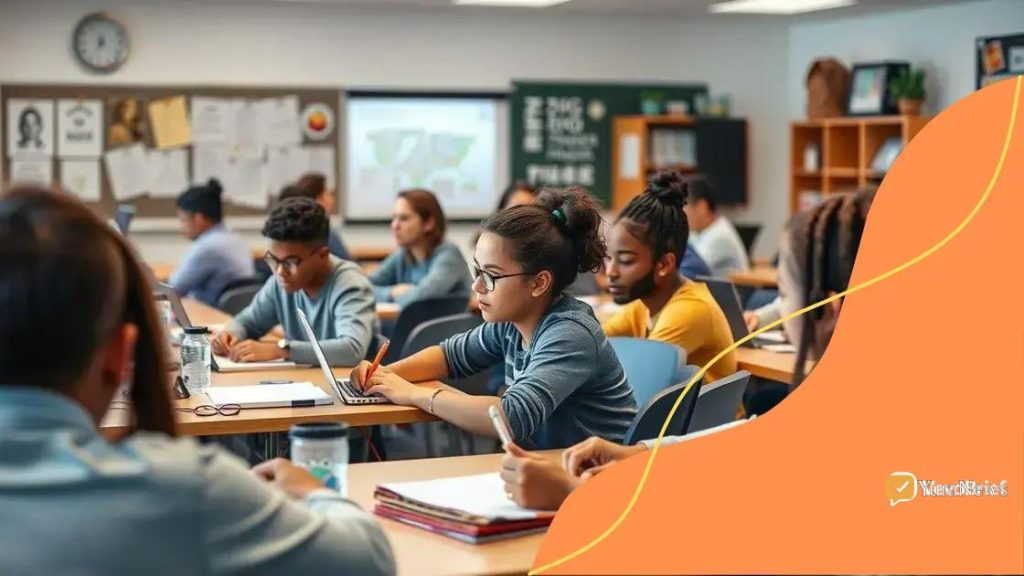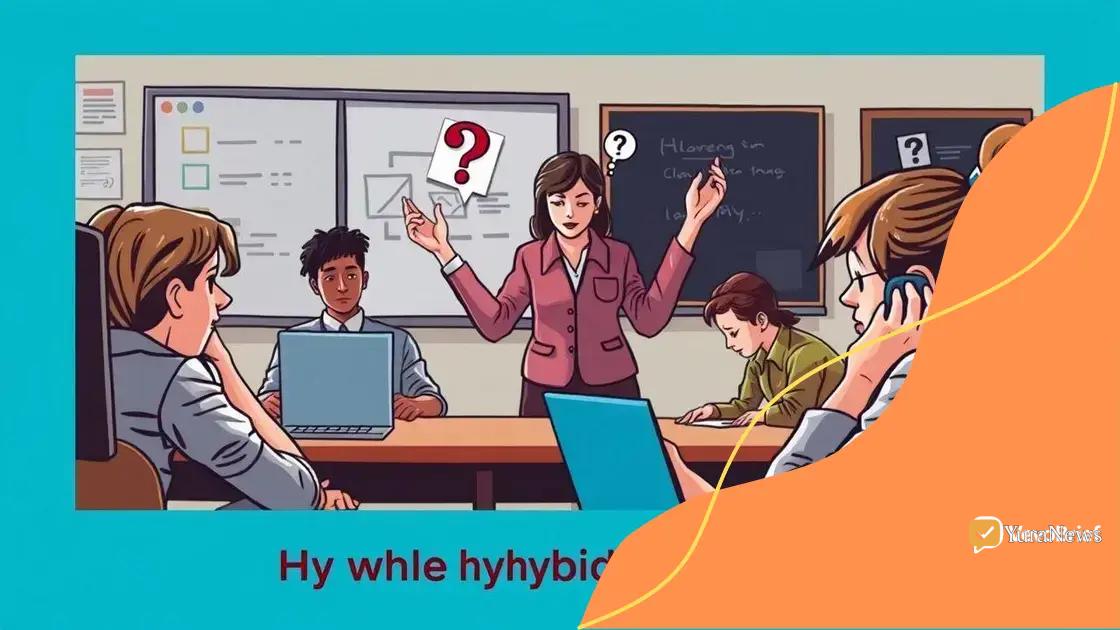Hybrid learning more common: the future of education

Anúncios
Hybrid learning combines online and traditional education, offering benefits such as increased accessibility, enhanced engagement, and personalized experiences, while also facing challenges like technology access and the need for effective teacher training.
Hybrid learning more common is changing the way we approach education today. With a mix of online and traditional classroom experiences, this method encourages engagement and flexibility. Have you ever wondered how it could benefit students and educators alike?
Anúncios
Understanding hybrid learning
Understanding hybrid learning is essential as it combines the best of traditional classrooms and online education. This learning approach offers flexibility and accessibility, making it suitable for various learners. How do we define this blend of methods? Let’s explore!
What is Hybrid Learning?
Hybrid learning is a model where students learn through a mix of in-person classes and digital environments. It allows students to engage with material from anywhere, giving them a chance to learn at their own pace.
Key Features of Hybrid Learning
- Flexibility: Students can attend classes remotely or in-person.
- Engagement: Interactive tools enhance participation.
- Personalization: Learners can choose resources that fit their needs.
When thinking about hybrid learning, it’s important to recognize how it supports different learning styles. Some students thrive in a traditional setting, while others excel online. This flexibility is crucial for today’s diverse educational landscape.
Anúncios
The technology used also plays a vital role. With platforms that facilitate user interaction, students remain connected and engaged. Furthermore, it reduces barriers for those who might struggle attending classes physically.
Ultimately, understanding hybrid learning involves appreciating the balance between technology and human interaction. It’s not just about delivering content; it’s about creating a rich, interactive learning experience that respects individual preferences and encourages collaboration.
Benefits of hybrid learning environments
The benefits of hybrid learning environments are numerous and impactful. This approach combines in-person teaching with online resources, enhancing the educational experience for students. Let’s dive into the advantages that this flexible system offers.
Increased Accessibility
One major benefit is that hybrid learning provides increased accessibility. Students can learn from various locations, making it easier for those with transportation challenges. This accessibility ensures that education is available to more learners, regardless of their circumstances.
Enhanced Engagement
Hybrid learning also fosters greater student engagement. By integrating different formats, educators can cater to various learning styles. Students who may struggle in a traditional classroom setting often find online components more engaging and interactive.
- Flexible scheduling: Students can manage their time better.
- Access to diverse resources: Online tools and materials are readily available.
- Personalized learning: Tailored experiences cater to individual needs.
Moreover, hybrid learning encourages collaboration among students. They can interact in person and online, building stronger connections. This balance helps develop important skills, such as teamwork and communication.
Another notable advantage is the ability for instructors to innovate. They can effortlessly incorporate new digital tools and methodologies into their teaching. This not only enriches their teaching practices but also allows them to stay current with educational trends.
Overall, the benefits of hybrid learning environments enhance both teaching and learning experiences, creating a more effective and accessible educational system.
Challenges of implementing hybrid learning

While there are many benefits, the challenges of implementing hybrid learning cannot be overlooked. These challenges can affect both educators and students alike. Understanding these obstacles is important to create effective strategies.
Technological Barriers
One of the primary challenges is ensuring that all students have access to the necessary technology. Not every student has a reliable device or internet connection at home. This digital divide can leave some learners behind.
Teacher Training and Support
Another significant challenge involves teacher training. Educators must be comfortable with new technologies and teaching methods. Many teachers feel overwhelmed by the rapid changes in educational technology.
- Time constraints: Teachers may lack the time to learn new tools effectively.
- Professional development: Access to training programs might be limited.
- Support systems: Schools must provide adequate support for teachers and students.
Moreover, student motivation can also be a hurdle. In a hybrid setting, some students may struggle to engage with online material. It’s essential to keep students motivated and involved.
Furthermore, adapting curricula for hybrid learning poses its own difficulties. Teachers must create lessons that work for both in-person and online formats. This process can be time-consuming and complex.
The challenges of implementing hybrid learning highlight the need for careful planning and resources. Addressing these issues is crucial to make hybrid learning successful for everyone involved.
Best practices for effective hybrid learning
Implementing best practices for effective hybrid learning can greatly enhance the educational experience for both students and teachers. These practices take into account the unique aspects of combining online and in-person instruction, ensuring that all learners thrive.
Clear Communication
Establishing clear communication is vital. Teachers should set expectations early and ensure that students know how to access resources and assignments. Consistent communication also helps to keep students engaged and informed.
Interactive Learning Activities
Incorporating interactive learning activities ensures that students remain focused. This might include group discussions, polls, and multimedia presentations. These engaging methods cater to different learning styles and promote collaboration.
- Use technology effectively: Leverage tools like video conferencing and learning management systems.
- Regular feedback: Provide timely feedback on assignments to support student growth.
- Flexible pacing: Allow students to learn at their own pace, especially in online settings.
Another essential practice is to create a structured schedule. Having a consistent routine helps students manage their time more effectively, leading to better learning outcomes. This structure benefits both in-person and online students.
Moreover, involving parents and guardians in the learning process strengthens support for students. Keeping families informed encourages them to participate in their child’s education. Setting up regular check-ins or newsletters can be very beneficial.
By adopting these best practices for effective hybrid learning, educators can foster a supportive and engaging learning environment, ensuring that all students achieve their academic goals.
Future trends in hybrid learning
The future trends in hybrid learning promise to transform education even more significantly. As technology continues to evolve, so do the methods educators use to engage students. This is an exciting time for learners and teachers alike.
Increased Use of Artificial Intelligence
One key trend is the increased use of artificial intelligence (AI) in education. AI can personalize learning experiences by analyzing student performance and suggesting resources that match their needs. This level of customization will help students learn more efficiently.
More Collaborative Tools
Another important trend involves enhanced collaborative tools. Virtual reality (VR) and augmented reality (AR) are becoming more accessible. These technologies allow students to have immersive learning experiences, making lessons more engaging. Collaboration among peers will go beyond the classroom as they work together on projects from different locations.
- Interactive platforms: New apps will facilitate seamless communication and resource sharing.
- Gamification: Implementing game-like elements will increase motivation and engagement.
- Diverse content delivery: Videos, podcasts, and interactive quizzes will diversify learning methods.
Additionally, there will be a stronger focus on emotional and social learning. Educators will prioritize students’ well-being, recognizing that a supportive environment fosters better learning. This holistic approach will lead to improved outcomes for students.
As we look ahead, the future trends in hybrid learning will integrate technology and traditional methods to create an enriching educational landscape. Educators will need to remain adaptable to harness these trends effectively.
FAQ – Frequently Asked Questions about Hybrid Learning
What are the main benefits of hybrid learning?
Hybrid learning combines online and in-person education, offering increased accessibility, personalized learning experiences, and enhanced student engagement.
What challenges do teachers face in hybrid learning environments?
Teachers may encounter issues like technology access for students, the need for effective training, and maintaining student motivation.
How can technology enhance hybrid learning?
Technology enables interactive tools, personalized learning, and better communication, making education more engaging for students.
What are some best practices for implementing hybrid learning?
Best practices include clear communication, interactive activities, regular feedback, and involving families in the learning process.